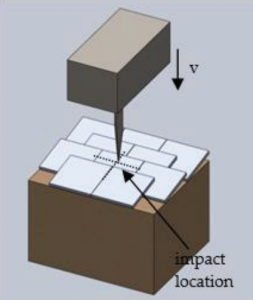As police officers participate in a multitude of daily, patrol, and even criminally-related duties, like narcotics investigations, they often deal with the threat of sharp force injury; to put it more plainly, there’s a good likelihood that they could get stabbed on the job. While there are several commercially available stab-resistant materials to keep police safe on the job, there are issues of comfort, poor fit, inflexibility, and weight, that can hinder an officer’s ability to perform his or her duties while wearing them.
3D printing has been called on before to help keep the police safe, and multiple researchers have used the technology to help create better protective gear, such as body armor. However, there hasn’t been much research conducted about using FDM 3D printing to fabricate protective body armor that’s stab-resistant, more lightweight, and with improved comfort.
A pair of researchers from the Universiti Teknikal Malaysia Melaka (UTeM) has set out to do just that, and published a paper, titled “Finite Element Analysis of Low Velocity Behaviour on Fused Deposition Modeling Printed Stab-Resistant Body Armour Design Features,” about their efforts.
The abstract reads, “Body armour is mainly worn to protect the human torso from attacks caused by weapons or projectiles. Despite a number of modern body armours have been developed, historical issue continue to exist and challenge the current protective solutions. However, additive manufacturing (AM) technology yet to be explored widely in attempt to address these issues. This research therefore investigates the feasibility of using AM system, specifically fused deposition modelling (FDM) process to manufacture textile geometrical models, which can be used for the development of novel user fit stab-resistant body armour. This study analyses the design features that could potentially influence the stab protection performance of FDM printed textile featuring an imbricated layout. This paper presents a finite element analysis to investigate the deformation distributed in the imbricated scale-like assemblies due to the knife blade penetrated through the overlapping scales vary with different scale thicknesses and overlapping angles. The results shows that 4mm model constructed in overlapping angle of 20˚ absorbed the most energy during the knife blade penetration. A weak region is found in between the overlapping scale of the single layer stab resistant model which could potentially allow the penetration of knife blade to cause injury.”
The researchers used FDM 3D printing to fabricate stab-resistant body armor out of ABS material, and conducted a study in order to find the right phenomenon with which to investigate the relationship between the design features of the 3D printed, imbricated (overlapping) scale-like assemblies that could affect its protection performance against stabbing.
“Therefore, a finite element analysis was performed on stab test of imbricated scale-like assemblies by varying the scale thickness and overlapping angle at knife impact energy level one,” the researchers explained.
They used ANSYS software to perform the simulation, and investigated the effects of “overlapping angles subjected to each imbricated scale-like assemblies,” as well as different scale thicknesses. One thing the study did not look at was the effects of blunt or ballistic trauma, like bruising; rather, it focused solely on preventing sharp force injuries.
“Deformation distributed in the body of every models and the depth of knife blade penetration as a result of impact mechanism into the FDM printed models were analysed,” the researchers wrote. “The study has also presented the energy absorption by the target models in order to analyse their stab protective performance.”
The researchers discovered that “the scale-like assemblies energy absorption by the imbricated scale-like model” built with a 20° overlapping angle and 4 mm scale thickness was the highest in the study, meaning it can provide more flexibility and stab resistance protection.
“In order to design the stab resistant body armour, the scale thickness and overlapping scale angle are the influence factors to the performance of the body armour,” the researchers concluded. “However, the weakness region in the arrangement of single layer stab resistance has to be noted, where the location between scales could potentially allow the penetration of knife blade and cause injury. Therefore, further design of single layer stab resistant body armour should avoid from such arrangement.”
Co-authors of the paper are S. Maidin and S. Y. Chong.
Discuss this research and other 3D printing topics at 3DPrintBoard.com or share your thoughts in the comments below.
Subscribe to Our Email Newsletter
Stay up-to-date on all the latest news from the 3D printing industry and receive information and offers from third party vendors.
You May Also Like
Further Understanding of 3D Printing Design at ADDITIV Design World
ADDITIV is back once again! This time, the virtual platform for additive manufacturing will be holding the first-ever edition of ADDITIV Design World on May 23rd from 9:00 AM –...
3D Printer Maker EVO-tech Reborn as NEVO3D — Once More With Feeling
EVO-tech was a 3D printing service and original equipment manufacturer established in 2013 and based in Schörfling am Attersee, Austria. The company produced high-quality material extrusion systems featuring linear bearings,...
3D Systems Brings 3D Printed PEEK Cranial Implant to the U.S. with FDA Clearance
For more than 10 years, 3D Systems (NYSE:DDD) has worked hand-in-hand with surgeons to plan over 150,000 patient-specific cases, and develop more than two million instruments and implants from its...
CDFAM Returns to Berlin for Second Annual Symposium
The second CDFAM Computational Design Symposium is scheduled for May 7-8, 2024, in Berlin, and will convene leading experts in computational design across all scales. Building upon the first event...



































